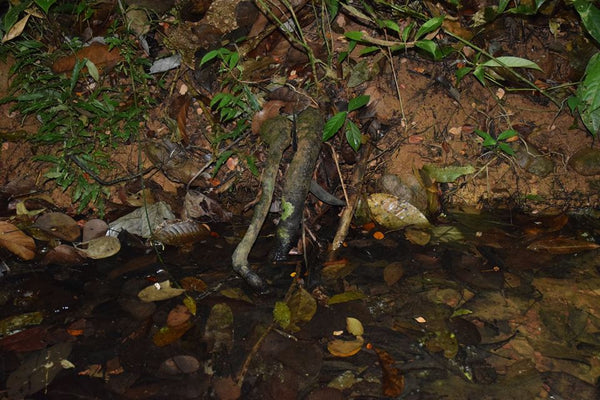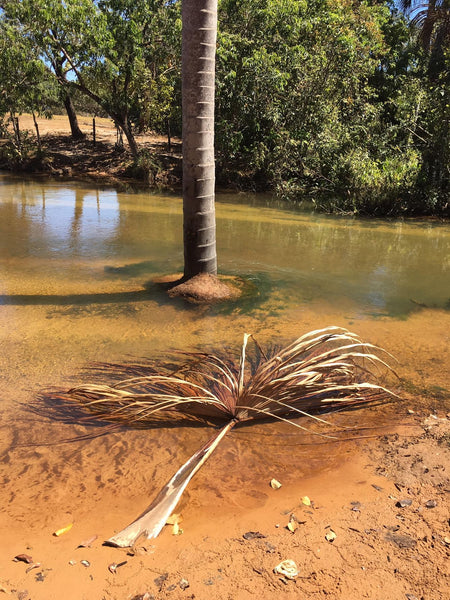- Continue Shopping
- Your Cart is Empty
Aquatic features we don't replicate enough...
The aquarium hobby is a funny beast- especially the art of aquascaping. It exists in a world halfway between kinetic art, home decorating, gardening, and biology. And it will challenge us to create work that draws from multiple disciplines. It seems to me that we spend as much time trying to find the right rock or piece of wood to create the "look" we want as we do even deciding what we're trying to replicate.

Yet, we often overlook the amazing inspiration that is offered up by Nature herself. Inspiration to create truly dynamic, uniquely "functionally aesthetic" aquariums. Here are a few habitats and ecological niches that we think deserve more representations in our aquairums:
Open, sandy habitats: Yeah, when you think about it, some of the most abundant and common areas in streams, rivers, and other bodies of water are accumulations of fine sand and small pebbles, with little to no "vertical relief" around. Areas like this are commonly occupied by fast-moving fishes, like Danios, or active, bottom-dwelling fishes like Corydoras.

In some areas, you'll find stands of aquatic vegetation, providing a sort of "oasis" for fishes, in which to forage, shelter, and spawn.

In some areas, you'll also find the occasional rock or two, and maybe a small branch or larger submerged log, palm fronds, etc. These create little "microhabitats" within the larger area.

Often very shallow (which bodes well for aquarium replication), often shaded by overhanging vegetation, and subject to variable currents, based on runoff or seasonal rains, these locations are interesting because they can sort of "evolve" over time into a different sort of habitat altogether.

When storms divert water into these streams, and fallen trees, branches, and other debris are tumbled into the water, flow patterns are disrupted, botanical materials are accumulated by these natural "dams", and the character of the environment changes into something altogether different.

So, you as an aquarist can take some "creative license" and attempt to replicate this "seasonal evolution" in the habitat by adding or removing botanical materials, like seed pods, leaves, branches, etc. This would make a for a very interesting and dynamic display!

Leaf Litter Bed Habitats: It might seem hard to believe, but for as much as we talk about creating leaf litter beds and their unique biology and function, we seldom see them replicated in aquariums. Without going into a lengthy analysis as to "why", let's just try to sell you on them a little bit more!

We love leaf litter beds- not just for the unique aesthetics that they present, but for the potential "functionality" these habitats bring to the aquarium. I think that these habitats, which host a huge variety of fishes, can be "foundational" for unlocking some new secrets of aquatic husbandry.

And by doing a bit of research on natural leaf litter habitats, you can glean some interesting tidbits of information that can be applied to aquarium design. And of course, you get perspective on the threats and challenges facing these habitats. Here's an example of one aspect of these habitats I learned about from a scientific study- the relationship between water depth and leaf litter depth- and how it can be applied to our aquarium designs:
In an area where the water depth was a maximum of 6ft/2 meters, the leaf litter depth was only about 8 inches/20cm. In a very shallow side tributary, the litter depth was about 4 inches/10cm, with the water level above it only about 12 inches/30cm!

That's like "aquarium depth", right? Yeah.
And, think about the idea of food sources, which are abundant in leaf litter...
The benthic microfauna which our fishes tend to feed on also are affected by this phenomenon, and as mentioned above, the fishes tend to "follow the food", making this a case of the fishes learning (?) to adapt to a changing environment. And perhaps...maybe...the idea of fishes sort of having to constantly adjust to a changing physical (note I didn't say "chemical") environment could be some sort of "trigger", hidden deep in their genetic code, that perhaps stimulates overall health, immunity or spawning?

Something in their "programing" that says, "You're at home..." Triggering specific adaptive behaviors?
I find this possibility fascinating, because we can learn more about our fishes' behaviors, and create really interesting habitats for them simply by adding botanicals to our aquariums and allowing them to "do their own thing"- to break apart as they decompose, move about as we change water or conduct maintenance activities, or add new pieces from time to time.

Again, much like Nature.
Like any environment, leaf litter beds have their own "rhythm", fostering substantial communities of fishes. The dynamic behind this biotope can best be summarized in this interesting excerpt from an academic paper on Blackwater leaf-litter communities by biologist Peter Alan Henderson, that is useful for those of us attempting to replicate these communities in our aquaria:
"..life within the litter is not a crowded, chaotic scramble for space and food. Each species occupies a sub-region defined by physical variables such as flow and oxygen content, water depth, litter depth and particle size…
...this subtle subdivision of space is the key to understanding the maintenance of diversity. While subdivision of time is also evident with, for example, gymnotids hunting by night and cichlids hunting by day, this is only possible when each species has its space within which to hide.”
So, for all of the above reasons, and many others that we can't touch on in this brief piece- consider trying to replicate a leaf litter bed habitat in your next aquarium!
Flooded forest floors, meadows, and Morichals: Okay, these are three distinct habitats, but they have similar characteristics in common. That being, they were all formerly terrestrial habitats, which are subjected to seasonal (or longer) inundation, which turns them into a rich aquatic habitat.

A prominent feature of many of these habitats is submerged terrestrial grasses, which tolerate some periods of submersion. Although many of the exact species of tropical grasses are unavailable in the hobby, we could select decent "surrogates" to represent them, by utilizing other terrestrial grasses, riparian plants, etc., and create a reasonable facsimile of such habitats in our aquariums.

The idea of flooded groves of terrestrial trees and shrubs, such as the "morichal", which is home to a variety of palms, the possibilities for replication in an aquarium are numerous and aesthetically interesting- challenging our skills and creativity.

So, you could either create an aquarium based on the underwater habitat around a single submerged palm, perhaps replicating it's trunk and the accumulation of materials which surround it, or, you could opt to simply represent the fronds, seed pods, and other materials on the substrate, a fascinating habitat in and of itself.

And of course, the idea of submerged forest floors, with their abundance of terrestrial materials, is where many of us DO play. However, being a bit more "literal" and trying to replicate specific locales and microhabitats within this broader "genre" is really something we'd like to see more of!

The dynamics of these habitats, with their abundant "use" of botanical materials and unique opportunities for replication, will continue to be a real "primary" source of inspiration for many in our communities, and I'm looking forward to seeing more and more aquariums based on them!
Root tangles and the water's edge: With our love for the complex and earthy habitats which arise when land meets water, and the abundance of natural materials now available for hobbyists (hey, there's that Tannin Aquatics company...😆), it's easier than ever to play with these niches in the aquarium.

Root tangles and their associated shorelines are remarkable for their "productivity" and the ability to attract fishes to forage, shelter, spawn, and live out their life cycles among.

There are so many approaches that you could take to replicating this dynamic in the aquarium. You could replicate the habitat with "roots" projecting from above the water's surface, creating an unusual "above/below" dynamic.

Or, you could focus on the roots of a tree in the "submerged" state, which is something irresistible to many hobbyists! We've done this in a pretty effective manner (if I say so, myself!) with our current brackish water system depicting the unique submerged roots of a mangrove habitat.

Or, you could focus on a sort of "fusion" of the above and below habitat, which is a most fascinating and aesthetically interesting niche to play with in the aquarium. The natural environment provides us with some incredible examples of this for iinspiration!

With so much to explore in the natural world, and so many habitats- or aspects of them- to replicate in the aquarium, we have unique opportunities to get out of our "comfort zones", study the form and function of them, and create great work. It will be really fun to see what kinds of representations our community will continue to push out to the world.

The inspiration of Nature as it is provides us with an almost unlimited opportunity to learn and express our creativity. By looking at some of these fascinating habitats with increased scrutiny, rather than simply replicating "that guy's" latest 'scape on Instagram or wherever, we're elevating the art and science of natural aquariums. We're also educating the uninitiated to the hobby about the dynamics, function, and threats that these environments face, which is perhaps the biggest "win" of all!

As always, express yourself as you see fit- but do consider some of the amazing features which Nature has created as an inspiration.
Stay observant. Stay engaged. Stay studious. Stay diligent. Stay creative...
And Stay Wet.
Scott Fellman
Tannin Aquatics
2 Responses
Scott Fellman
LOL, believe it or not, the actual truth of this is to publicly shame MYSELF into setting up another tank or two (or three) featuring these habitats…But, hey, if you want to set one up, too- and order from us…well… who am I to discourage you? 😆
-Scott
Maarten Cappaert
I swear you are writing these to make me place my order, following what we talked about this week. :)







Scott Fellman
Author